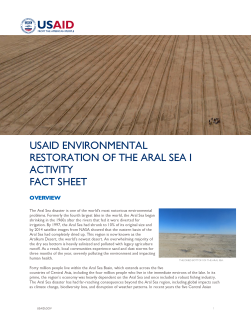2021 - 2024 | USAID Regional Water and Vulnerable Environment (WAVE) Activity | $1.35 million USD
The Aral Sea disaster is one of the world's most notorious environmental problems. Formerly the fourth largest lake in the world, the Aral Sea began shrinking in the 1960s after the rivers that fed it were diverted for irrigation. By 1997, the Aral Sea had shrunk to 10% of its original size and by 2014 satellite images from NASA showed that the eastern basin of the Aral Sea had completely dried up. This region is now known as the Aralkum Desert, the world’s newest desert. An overwhelming majority of the dry sea bottom is heavily salinized and polluted with legacy agriculture runoff. As a result, local communities experience sand and dust storms for three months of the year, severely polluting the environment and impacting human health.
Forty million people live within the Aral Sea Basin, which extends across the five countries of Central Asia, including the four million people who live in the immediate environs of the lake. In its prime, the region’s economy was heavily dependent on the Aral Sea and once included a robust fishing industry. The Aral Sea disaster has had far-reaching consequences beyond the Aral Sea region, including global impacts such as climate change, biodiversity loss, and disruption of weather patterns. In recent years the five Central Asian countries have collaborated to implement various projects and initiatives aimed at mitigating the environmental and social impacts of the Aral Sea disaster with a support from international development community.
GOAL
At the request of the Government of Kazakhstan, the U.S. Agency for International Development (USAID) has launched the Environmental Restoration of the Aral Sea I (ERAS-I) Activity. The goal of the activity is to provide environmental restoration measures to improve the resilience of landscapes in the Northern Aral Sea zone. The implementation of the Environmental Restoration of the Aral Sea I Activity supports regional transboundary cooperation for water and environment and enhances resilience to climate change for vulnerable populations and ecosystems.
The Environmental Restoration of the Aral Sea I Activity aims to introduce innovative measures to create an “Oasis” using black saxaul in the Northern Aral Sea zone, 50 km from the village of Karateren. The innovative methods – which include a research design to assess the optimal growth conditions for soil and watering – will create a stable ecological system with endemic species of flora and fauna.
PARTNERSHIP AND COLLABORATION
The Environmental Restoration of the Aral Sea I Activity is implemented by the USAID Regional Water and Vulnerable Environment (WAVE) Activity with assistance from the Executive Directorate of the International Fund for Saving the Aral Sea in the Republic of Kazakhstan and in close partnership with the Ministry of Ecology and Natural Resources of the Republic of Kazakhstan and local state bodies.
KEY RESULTS
In 2021, site work began at the Oasis, which involved cutting 300 furrows, each 2.5 km in length, across 500 hectares of land. These furrows were created to collect clean sand and trap additional moisture, which, in turn, will create a suitable environment for saxaul and other shrub seeds to take root and grow.
As of March 2023, the Activity has planted approximately 200,000 black saxaul seedlings across 18 five-hectare plots, which are being observed under various growing conditions including different types of fencing, treatment with hydrogel, and watering methods. The survival rates and plant growth are recorded twice a year to determine most effective and efficient afforestation practices for helping this shrub flourish, while reducing the harmful sandstorms that plague farming and daily life in the region.
As well, ERAS-I has constructed a field station at the Oasis, providing an important hub from which to conduct research and carry out afforestation activities. A 9,000 meter fence has been erected around the perimeter of the Oasis to protect the black saxaul from wild animals, and work has commenced on a borehole well to provide irrigation to the site. The water will also recharge the groundwater reserves, ensuring the sustainability of afforestation efforts in the long run.
IMPLEMENTATION PERIOD: October 2021- September 2024
BUDGET: $1.35 million USD
CONTACT: Gulzada Azhetova, Contracting Officer Representative, gazhetova@usaid.gov


